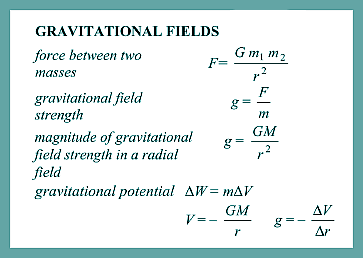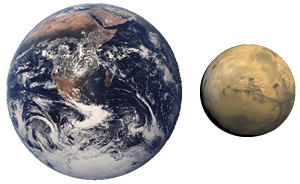Gravitational fields - Multiple Choice Q1 Masses of M and 2M exert a gravitational force F on each other when the distance between their centres is r. What is the gravitational force between masses of 2M and 4M when the distance between their centres is 4r?
F ∝Mm/r2 Increasing the mass product from 2 to 8 would increase F by a factor of 4 Quadrupling the radius would decrease F by 42 Combining the two factors we get 4/16 = 1/4 = 0.25 Choice A
Q2 A planet has a radius half the Earth's radius and a mass a quarter of the Earth's mass. What is the approximate gravitational field strength on the surface of the planet?
g ∝M/r2 Reducing the mass to a quarter would reduce g by a quarter Halving the radius would increase g by 22 Therefore the two factors would cancel each other out, and g would be the same as on Earth. Choice C
Q3. At the surface of the Earth:
The radius of the Earth is R. An object, whose weight on the surface of the Earth is W, is moved to a height 3R above the surface. Which line, A to D, in the table gives the weight of the object and the gravitational potential at this height?
W = mg
W1r12 = W2r22 W1 = W r1 = r r2 = 4r (r (radius of the planet) + 3R above the surface) ∴ Wr2 = W2 x 16r2 W2 = W/16
V = - GM/r and let us make the mass be 'm'
V = - mGM/r At height 3r above the surface it would be - mGM/4r = ¼V Choice A
Q4. A satellite of mass m travels in a circular orbit of radius r around a planet of mass M. Which one of the following expressions gives the angular speed of the satellite?
The length of the path is 2πr (the circumference of a circle) So v = 2πr/T
To make one full revolution Δθ would be 2π (as there are 2π radians in a full circle) Period T is the time taken for one full cycle - or one full revolution So we have Δθ = 2π and Δt = T So we get: ω =2π/T But 2π/T = v/r so, ω =v/r
F = mv2/r
v = √(Fr/m)
F = GMm/R2 ∴ the velocity of the satellite is given by v = √[(GmM/r2) x (r/m)] v = √(GM/r) Therefore ω = √(GM/r)/r ω = √(GM/r3) Choice D
Q5. Which one of the following has different units to the other three?
Q6. The diagram shows two objects of equal mass m separated by a distance r.
Which line, A to D, in the table gives the correct values of the gravitational field strength and gravitational potential at the mid-point P between the two objects?
Therefore the result will be zero.
For an object placed at point P work would have to be done against the pull of both masses to move it to infinity - the result is therefore the sum of the potentials and the potential will be the expression not the zero
Q7. Mars has a diameter approximately 0.5 that of the Earth, and a mass of 0.1 that of the Earth.
If the gravitational potential at the Earth’s surface is –63 MJ kg–1, what is the approximate value of the gravitational potential at the surface of Mars?
Vr/M = -G (a constant) so VErE/ME = VMrM/MM VM = VE x MM/ME x rE/rM VM = -63 x 0.1 x 2 VM = 12.6 MJ kg–1 Choice A Q8. A small mass is situated at a point on a line joining two large masses ml and m2 such that it experiences no resultant gravitational force. If its distance from the mass m1 is r1 and its distance from the mass m2 is r2, what is the value of the ratio ?
∴ m1/r12 = m2/r22 r22/r12 = m2/m1 r12/r22 = m1/m2 r1/r2= (m1/m2)0.5 Choice C Q9. A projectile moves in a gravitational field. Which one of the following is a correct statement for the gravitational force acting on the projectile?
Q10. The diagram shows two positions, X and Y, at different heights on the surface of the Earth.
Which line, A to D, in the table gives correct comparisons at X and Y for gravitational potential and angular velocity?
|
Follow me...
|










